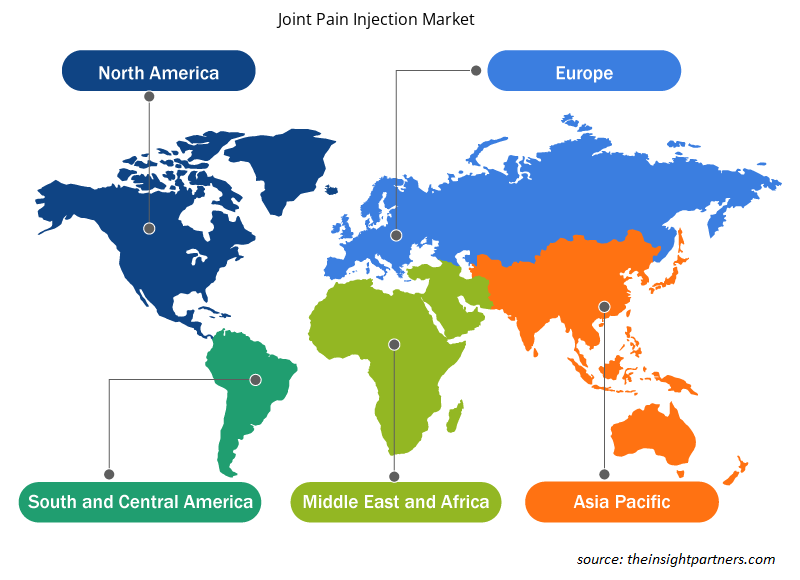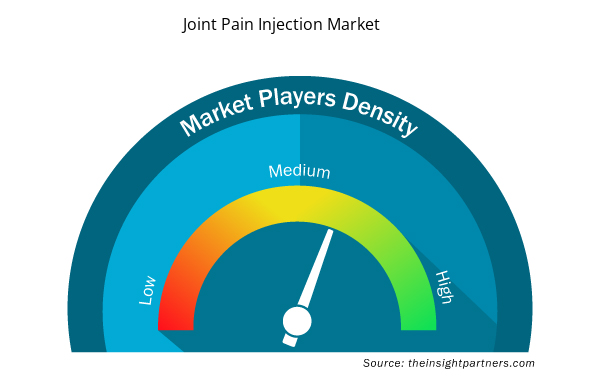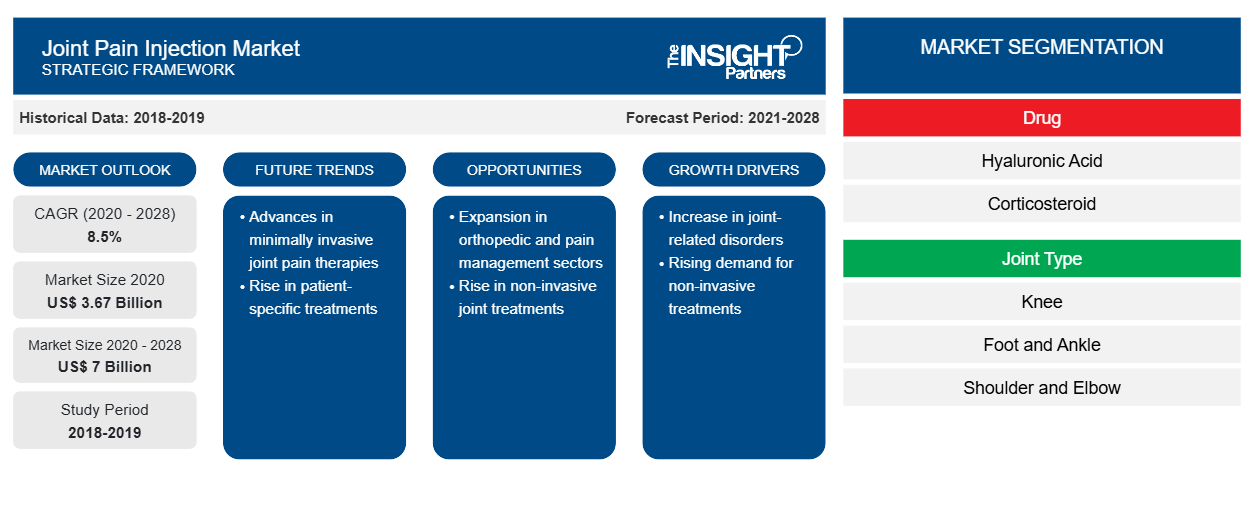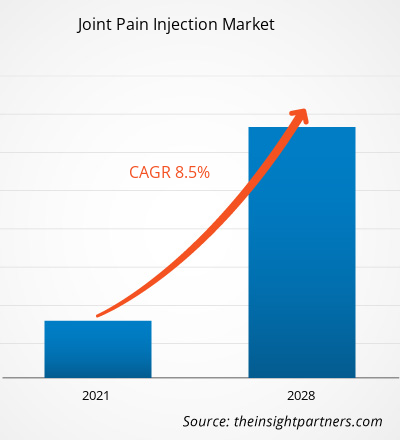[Forschungsbericht] Der Markt für Injektionen gegen Gelenkschmerzen soll von 3.667,45 Millionen US-Dollar im Jahr 2020 auf 6.996,88 Millionen US-Dollar im Jahr 2028 anwachsen; für den Zeitraum 2021–2028 wird ein durchschnittliches jährliches Wachstum von 8,5 % erwartet.
Injektionen gegen Gelenkschmerzen lindern starke Schmerzen schneller und reduzieren Gelenkentzündungen. Zu den auf dem Markt erhältlichen Injektionsarten gehören Kortikosteroid-Injektionen, Hyaluronsäure-Injektionen (HA), plättchenreiche Plasma-Injektionen (PRP) und Plazentagewebematrix-Injektionen (PTM). Das Wachstum des Marktes für Injektionen gegen Gelenkschmerzen wird auf Faktoren wie die hohe Prävalenz von Erkrankungen des Bewegungsapparats und die zunehmende Zahl von Sportverletzungen zurückgeführt. Die hohen Kosten für Gelenkreparaturtherapien behindern jedoch das Marktwachstum.
Markteinblicke
Hohe Prävalenz von Muskel-Skelett-Erkrankungen
Passen Sie diesen Bericht Ihren Anforderungen an
Sie erhalten kostenlos individuelle Anpassungen an jedem Bericht, einschließlich Teilen dieses Berichts oder einer Analyse auf Länderebene, eines Excel-Datenpakets sowie tolle Angebote und Rabatte für Start-ups und Universitäten.
- Holen Sie sich die wichtigsten Markttrends aus diesem Bericht.Dieses KOSTENLOSE Beispiel umfasst eine Datenanalyse von Markttrends bis hin zu Schätzungen und Prognosen.
Muskel-Skelett-Erkrankungen sind Erkrankungen, die Muskeln, Knochen und Gelenke von Nacken, Schultern, Handgelenken, Rücken, Hüften, Beinen, Knien und Füßen betreffen. Zu diesen Erkrankungen zählen Sehnenentzündungen, Karpaltunnelsyndrom, Osteoarthritis, rheumatoide Arthritis (RA), Fibromyalgie und Knochenbrüche. Laut dem 2018 aktualisierten Factsheet der Weltgesundheitsorganisation (WHO) sind Muskel-Skelett-Erkrankungen die zweithäufigste Ursache für Behinderungen weltweit. Demnach wird erwartet, dass die Prävalenz und Auswirkung von Muskel-Skelett-Erkrankungen mit der zunehmenden Alterung der Bevölkerung und der Zunahme der Prävalenz von Risikofaktoren für nichtübertragbare Krankheiten (NCDs) weltweit zunehmen werden. Laut den Daten der Jahrestagung 2016 der American Academy of Orthopedic Surgeons leidet in den USA etwa jeder zweite Erwachsene an einer Muskel-Skelett-Erkrankung. Laut den Centers for Disease Control and Prevention (CDC) verursacht Arthritis außerdem starke Schmerzen, die jedes Jahr Millionen von Menschen in den USA betreffen. Etwa jeder vierte Arthritispatient, also etwa 15 Millionen von insgesamt etwa 54 Millionen Patienten, leidet unter starken arthritisbedingten Gelenkschmerzen.
Darüber hinaus ist Osteoarthritis (OA) eine der häufigsten Gelenkerkrankungen in den USA und wird durch den Abbau des Gelenkknorpels zwischen den Knochen verursacht. Sie ist auch als degenerative Gelenkerkrankung oder „Verschleißarthritis“ bekannt. Laut den Centers for Disease Control and Prevention (CDC) leiden mehr als 32,5 Millionen Erwachsene in den USA an Osteoarthritis. Ebenso leiden laut dem National Health Service (NHS) mehr als 10 Millionen Menschen in Großbritannien an Arthritis oder anderen ähnlichen Erkrankungen, die die Gelenke betreffen. Laut Bupa Health Insurance ist Osteoarthritis die häufigste Form von Arthritis in Großbritannien und betrifft etwa ein Drittel der über 45-Jährigen im Land, also etwa 8,75 Millionen Menschen. Daher führt eine so hohe Prävalenz von Erkrankungen des Bewegungsapparats in verschiedenen Ländern zu einer Erhöhung der Anzahl der Behandlungsverfahren, die für diese Erkrankungen durchgeführt werden, was wiederum das Wachstum des Marktes für Gelenkschmerzinjektionen vorantreibt.
Arzneimittelbasierte Erkenntnisse
Der Markt für Gelenkschmerzinjektionen ist nach Arzneimitteln in Hyaluronsäure, Kortikosteroide und andere unterteilt. Das Kortikosteroidsegment hatte im Jahr 2020 den größten Marktanteil und wird voraussichtlich im Prognosezeitraum die höchste durchschnittliche jährliche Wachstumsrate verzeichnen.
Erkenntnisse basierend auf Gelenktypen
Basierend auf dem Gelenktyp ist der Markt für Gelenkschmerzinjektionen in Knie, Fuß und Knöchel, Schulter und Ellenbogen, Hüfte und andere Anwendungen unterteilt. Das Kniesegment hatte im Jahr 2020 den größten Marktanteil und wird im Prognosezeitraum voraussichtlich die höchste durchschnittliche jährliche Wachstumsrate auf dem Markt verzeichnen.
Regionale Einblicke in den Markt für Gelenkschmerzinjektionen
Die regionalen Trends und Faktoren, die den Markt für Gelenkschmerzinjektionen während des Prognosezeitraums beeinflussen, wurden von den Analysten von Insight Partners ausführlich erläutert. In diesem Abschnitt werden auch die Marktsegmente und die Geografie von Gelenkschmerzinjektionen in Nordamerika, Europa, im asiatisch-pazifischen Raum, im Nahen Osten und Afrika sowie in Süd- und Mittelamerika erörtert.

- Erhalten Sie regionale Daten zum Markt für Gelenkschmerzinjektionen
Umfang des Marktberichts zur Injektion von Gelenkschmerzen
| Berichtsattribut | Details |
|---|---|
| Marktgröße im Jahr 2020 | 3,67 Milliarden US-Dollar |
| Marktgröße bis 2028 | 7 Milliarden US-Dollar |
| Globale CAGR (2020 - 2028) | 8,5 % |
| Historische Daten | 2018-2019 |
| Prognosezeitraum | 2021-2028 |
| Abgedeckte Segmente | Nach Medikament
|
| Abgedeckte Regionen und Länder | Nordamerika
|
| Marktführer und wichtige Unternehmensprofile |
|
Dichte der Marktteilnehmer für Gelenkschmerzinjektionen: Die Auswirkungen auf die Geschäftsdynamik verstehen
Der Markt für Gelenkschmerzinjektionen wächst rasant, angetrieben durch die steigende Endverbrauchernachfrage aufgrund von Faktoren wie sich entwickelnden Verbraucherpräferenzen, technologischen Fortschritten und einem größeren Bewusstsein für die Vorteile des Produkts. Mit steigender Nachfrage erweitern Unternehmen ihr Angebot, entwickeln Innovationen, um die Bedürfnisse der Verbraucher zu erfüllen, und nutzen neue Trends, was das Marktwachstum weiter ankurbelt.
Die Marktteilnehmerdichte bezieht sich auf die Verteilung der Firmen oder Unternehmen, die in einem bestimmten Markt oder einer bestimmten Branche tätig sind. Sie gibt an, wie viele Wettbewerber (Marktteilnehmer) in einem bestimmten Marktraum im Verhältnis zu seiner Größe oder seinem gesamten Marktwert präsent sind.
Die wichtigsten auf dem Markt für Gelenkschmerzinjektionen tätigen Unternehmen sind:
- Chugai Pharmaceutical Co., Ltd.
- Bioventus Inc.
- Fidia Pharma USA Inc.
- Flexion Therapeutics, Inc.
- SEIKAGAKU CORPORATION
Haftungsausschluss : Die oben aufgeführten Unternehmen sind nicht in einer bestimmten Reihenfolge aufgeführt.

- Überblick über die wichtigsten Akteure auf dem Markt für Gelenkschmerz-Injektionen
Einblicke basierend auf Vertriebskanälen
Basierend auf dem Vertriebskanal ist der Markt für Gelenkschmerzinjektionen in Einzelhandelsapotheken, Krankenhausapotheken und andere unterteilt. Das Segment Wundversorgung hatte 2020 den größten Marktanteil, und das Segment Knochentransplantate dürfte im Prognosezeitraum die höchste durchschnittliche jährliche Wachstumsrate auf dem Markt verzeichnen.
Produkteinführungen und Zulassungen sind die von Unternehmen am häufigsten angewandten Strategien, um ihre globale Präsenz und ihr Produktportfolio zu erweitern. Darüber hinaus konzentrieren sich die Akteure auf dem Markt für Gelenkschmerzinjektionen auf die Kooperationsstrategie, um ihren Kundenstamm zu vergrößern, was ihnen wiederum ermöglicht, ihren Markennamen weltweit aufrechtzuerhalten.
Markt für Gelenkschmerzinjektionen – nach Arzneimittel
- Hyaluronsäure
- Kortikosteroid
- Sonstiges
Markt für Gelenkschmerzinjektionen – nach Gelenktyp
- Knie
- Fuß und Knöchel
- Schulter und Ellenbogen
- Hüfte
- Sonstiges
Markt für Gelenkschmerzinjektionen – nach Vertriebskanälen
- Einzelhandelsapotheken
- Krankenhäuser Apotheken
- Sonstiges
Markt für Gelenkschmerzinjektionen – nach Geografie
Nordamerika
- UNS
- Kanada
- Mexiko
Europa
- Frankreich
- Deutschland
- Italien
- Vereinigtes Königreich
- Spanien
- Restliches Europa
Asien-Pazifik (APAC)
- China
- Indien
- Südkorea
- Japan
- Australien
- Restlicher Asien-Pazifik-Raum
Naher Osten und Afrika (MEA)
- Südafrika
- Saudi-Arabien
- Vereinigte Arabische Emirate
- Restlicher Naher Osten und Afrika
Süd- und Mittelamerika (SCAM)
- Brasilien
- Argentinien
- Restliches Süd- und Mittelamerika
Firmenprofile
- Chugai Pharmaceutical Co., Ltd.
- Bioventus Inc.
- Fidia Pharma USA Inc.
- Flexion Therapeutics, Inc.
- SEIKAGAKU CORPORATION
- Ferring BV
- Sanofi
- Anika Therapeutics, Inc.
- Teva Pharma
- OrthogenRx, Inc.
- Historische Analyse (2 Jahre), Basisjahr, Prognose (7 Jahre) mit CAGR
- PEST- und SWOT-Analyse
- Marktgröße Wert/Volumen – Global, Regional, Land
- Branche und Wettbewerbsumfeld
- Excel-Datensatz



Report Coverage
Revenue forecast, Company Analysis, Industry landscape, Growth factors, and Trends

Segment Covered
This text is related
to segments covered.

Regional Scope
North America, Europe, Asia Pacific, Middle East & Africa, South & Central America

Country Scope
This text is related
to country scope.
Häufig gestellte Fragen
The joint pain injection market majorly consists of the players such as Chugai Pharmaceutical Co., Ltd., Teva Pharmaceuticals, Bioventus Inc., Fidia Pharma USA Inc., Flexion Therapeutics, Inc., SEIKAGAKU CORPORATION, Ferring B.V., Sanofi, Anika Therapeutics, Inc., and OrthogenRx among others.
The global joint pain injection market growth is mainly attributed to factors such the high prevalence of musculoskeletal disorders and increasing number of sports injuries. However, the high costs of joint repair therapies hinder the market growth.
Joint pain injections are medicinal fluids inserted in the patient’s body to get faster relief from severe pain. The joint pain injections are used to reduce inflammation in the joints. There are several types of injections available in the market which are corticosteroids injections, hyaluronic acid (HA) injections, platelet-rich plasma (PRP) injections and placental tissue matrix (PTM) injections.
Trends and growth analysis reports related to Life Sciences : READ MORE..
The List of Companies - Joint Pain Injection Market
- Chugai Pharmaceutical Co., Ltd.
- Bioventus Inc.
- Fidia Pharma USA Inc.
- Flexion Therapeutics, Inc.
- SEIKAGAKU CORPORATION
- Ferring B.V.
- Sanofi
- Anika Therapeutics, Inc.
- Teva Pharmaceutical
- OrthogenRx, Inc.
The Insight Partners performs research in 4 major stages: Data Collection & Secondary Research, Primary Research, Data Analysis and Data Triangulation & Final Review.
- Data Collection and Secondary Research:
As a market research and consulting firm operating from a decade, we have published and advised several client across the globe. First step for any study will start with an assessment of currently available data and insights from existing reports. Further, historical and current market information is collected from Investor Presentations, Annual Reports, SEC Filings, etc., and other information related to company’s performance and market positioning are gathered from Paid Databases (Factiva, Hoovers, and Reuters) and various other publications available in public domain.
Several associations trade associates, technical forums, institutes, societies and organization are accessed to gain technical as well as market related insights through their publications such as research papers, blogs and press releases related to the studies are referred to get cues about the market. Further, white papers, journals, magazines, and other news articles published in last 3 years are scrutinized and analyzed to understand the current market trends.
- Primary Research:
The primarily interview analysis comprise of data obtained from industry participants interview and answers to survey questions gathered by in-house primary team.
For primary research, interviews are conducted with industry experts/CEOs/Marketing Managers/VPs/Subject Matter Experts from both demand and supply side to get a 360-degree view of the market. The primary team conducts several interviews based on the complexity of the markets to understand the various market trends and dynamics which makes research more credible and precise.
A typical research interview fulfils the following functions:
- Provides first-hand information on the market size, market trends, growth trends, competitive landscape, and outlook
- Validates and strengthens in-house secondary research findings
- Develops the analysis team’s expertise and market understanding
Primary research involves email interactions and telephone interviews for each market, category, segment, and sub-segment across geographies. The participants who typically take part in such a process include, but are not limited to:
- Industry participants: VPs, business development managers, market intelligence managers and national sales managers
- Outside experts: Valuation experts, research analysts and key opinion leaders specializing in the electronics and semiconductor industry.
Below is the breakup of our primary respondents by company, designation, and region:

Once we receive the confirmation from primary research sources or primary respondents, we finalize the base year market estimation and forecast the data as per the macroeconomic and microeconomic factors assessed during data collection.
- Data Analysis:
Once data is validated through both secondary as well as primary respondents, we finalize the market estimations by hypothesis formulation and factor analysis at regional and country level.
- Macro-Economic Factor Analysis:
We analyse macroeconomic indicators such the gross domestic product (GDP), increase in the demand for goods and services across industries, technological advancement, regional economic growth, governmental policies, the influence of COVID-19, PEST analysis, and other aspects. This analysis aids in setting benchmarks for various nations/regions and approximating market splits. Additionally, the general trend of the aforementioned components aid in determining the market's development possibilities.
- Country Level Data:
Various factors that are especially aligned to the country are taken into account to determine the market size for a certain area and country, including the presence of vendors, such as headquarters and offices, the country's GDP, demand patterns, and industry growth. To comprehend the market dynamics for the nation, a number of growth variables, inhibitors, application areas, and current market trends are researched. The aforementioned elements aid in determining the country's overall market's growth potential.
- Company Profile:
The “Table of Contents” is formulated by listing and analyzing more than 25 - 30 companies operating in the market ecosystem across geographies. However, we profile only 10 companies as a standard practice in our syndicate reports. These 10 companies comprise leading, emerging, and regional players. Nonetheless, our analysis is not restricted to the 10 listed companies, we also analyze other companies present in the market to develop a holistic view and understand the prevailing trends. The “Company Profiles” section in the report covers key facts, business description, products & services, financial information, SWOT analysis, and key developments. The financial information presented is extracted from the annual reports and official documents of the publicly listed companies. Upon collecting the information for the sections of respective companies, we verify them via various primary sources and then compile the data in respective company profiles. The company level information helps us in deriving the base number as well as in forecasting the market size.
- Developing Base Number:
Aggregation of sales statistics (2020-2022) and macro-economic factor, and other secondary and primary research insights are utilized to arrive at base number and related market shares for 2022. The data gaps are identified in this step and relevant market data is analyzed, collected from paid primary interviews or databases. On finalizing the base year market size, forecasts are developed on the basis of macro-economic, industry and market growth factors and company level analysis.
- Data Triangulation and Final Review:
The market findings and base year market size calculations are validated from supply as well as demand side. Demand side validations are based on macro-economic factor analysis and benchmarks for respective regions and countries. In case of supply side validations, revenues of major companies are estimated (in case not available) based on industry benchmark, approximate number of employees, product portfolio, and primary interviews revenues are gathered. Further revenue from target product/service segment is assessed to avoid overshooting of market statistics. In case of heavy deviations between supply and demand side values, all thes steps are repeated to achieve synchronization.
We follow an iterative model, wherein we share our research findings with Subject Matter Experts (SME’s) and Key Opinion Leaders (KOLs) until consensus view of the market is not formulated – this model negates any drastic deviation in the opinions of experts. Only validated and universally acceptable research findings are quoted in our reports.
We have important check points that we use to validate our research findings – which we call – data triangulation, where we validate the information, we generate from secondary sources with primary interviews and then we re-validate with our internal data bases and Subject matter experts. This comprehensive model enables us to deliver high quality, reliable data in shortest possible time.


 Holen Sie sich ein kostenloses Muster für diesen Bericht
Holen Sie sich ein kostenloses Muster für diesen Bericht